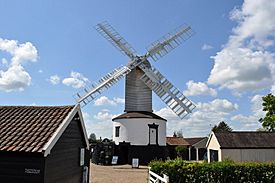Saxtead Green Windmill facts for kids
Quick facts for kids Saxtead Green Post Mill |
|
|---|---|

Saxtead Green Post Mill
|
|
| Origin | |
| Mill name | Saxtead Green Post Mill |
| Grid reference | TM 253 644 |
| Coordinates | 52°13′54″N 1°17′54″E / 52.2318°N 1.2984°E |
| Operator(s) | English Heritage |
| Year built | Late 18th century |
| Information | |
| Purpose | Corn mill |
| Type | Post mill |
| Storeys | Three storey buck |
| Roundhouse storeys | Three storey roundhouse |
| No. of sails | Four sails |
| Type of sails | Patent sails |
| Windshaft | Cast iron |
| Winding | Fantail |
| Fantail blades | Six blades |
| No. of pairs of millstones | Two pairs |
The Saxtead Green Post Windmill is a very old and special windmill located in Saxtead Green, near Woodbridge, Suffolk, England. It is a type of windmill called a post mill. This means its main body, or "buck," can turn to face the wind. The mill is a Grade II* listed building, which means it's an important historic structure. It is also a Scheduled monument, protected by the government. This windmill has been carefully restored so people can visit and learn about its history.
Contents
History of Saxtead Green Mill
Early Days and Changes
Records show that a windmill has stood in Saxtead since 1287. The current Saxtead Green Mill has been here since at least 1796. Amos Webber was the miller at that time. In 1810, a house for the miller, Robert Holmes, was built nearby.
Over its working life, the mill was made taller three times. Around 1853, strong winds damaged the sails. New sails were made. In 1854, special builders called millwrights installed new cast iron parts. They also changed how the grinding stones worked. This was when the mill was raised for the third time.
Later Years and Restoration
Millwrights continued to work on the mill in the 1870s and 1890s. From 1926, a millwright named Jesse Wightman helped with repairs. The mill stopped grinding grain for money in 1947. This was after the last miller passed away.
The mill then went to Mr. Steven Charles Sullivan. In 1951, he placed the mill under the care of the Ministry of Works. Today, the mill is still owned by the same family, Stephen and Jonathan Sullivan. Between 1957 and 1960, the mill was completely rebuilt. Jesse Wightman, the millwright, oversaw this big project. They even used a part from another windmill that had been taken down.
Since 1984, English Heritage has looked after the mill. In 2008, the mill was repaired again, and new sails were made.
Recent Restoration Project
In 2017, English Heritage closed the mill for a major restoration. This project cost about £250,000. A local millwright, Tim Whiting, led the work. He built a new set of sails and replaced the fantail. The fantail is a small windmill at the back that helps the main mill turn to face the wind. The mill was planned to reopen in April 2020. However, due to the Coronavirus pandemic, it reopened in 2021.
How Saxtead Green Mill Works
Saxtead Green Mill is a post mill. It has a three-storey roundhouse at its base. The main part of the mill, called the "buck," sits on a large central post. This buck can turn around to catch the wind.
The mill has four large sails, called Patent sails. These sails are connected to a strong cast-iron shaft. A small windmill, called a fantail, helps the main mill turn. The fantail makes sure the large sails always face the wind.
Inside the mill, there are two pairs of millstones. These stones grind the grain into flour. Most of the machinery inside is made of cast iron. However, the Brake Wheel, which helps control the speed, is made of strong oak wood.
Millers of Saxtead Green
Many people have worked as millers at Saxtead Green Mill over the years. Here are some of them:
- Amos Webber (1796)
- Robert Holmes (1810)
- George Holmes
- George William Holmes
- Mr Meadows
- Mr Steggles
- Mr Rouse
- Frederick Eldred
- Alfred Aldred
- Alfred Stephenson Robert Aldred (until 1947)
Visiting the Mill
The Saxtead Green Post Mill is open for visitors. You can explore this historic windmill on Fridays, Saturdays, and Bank Holidays. It is open from April 1st to September 30th each year.

